
Goose: 9 Super Facts about the Migratory Bird
Geese are the largest member of the duck family in size, and the length of their neck distinguishes a goose. It is also the largest bird that can fly. The goose weighs about 16 kg, and the male is larger in size and weight than the female. The geese that live in the north of the globe are distinguished by the fact that their feathers are white, while those in the southern hemisphere have black and white feathers, and there is another breed that lives in Australia in completely black colour and their young ones in grey.
It may be interesting to know that a male goose can be called a gander, while a female is sometimes called a dame. A baby goose is usually called a gosling, and a group of geese in the field is called a gaggle.
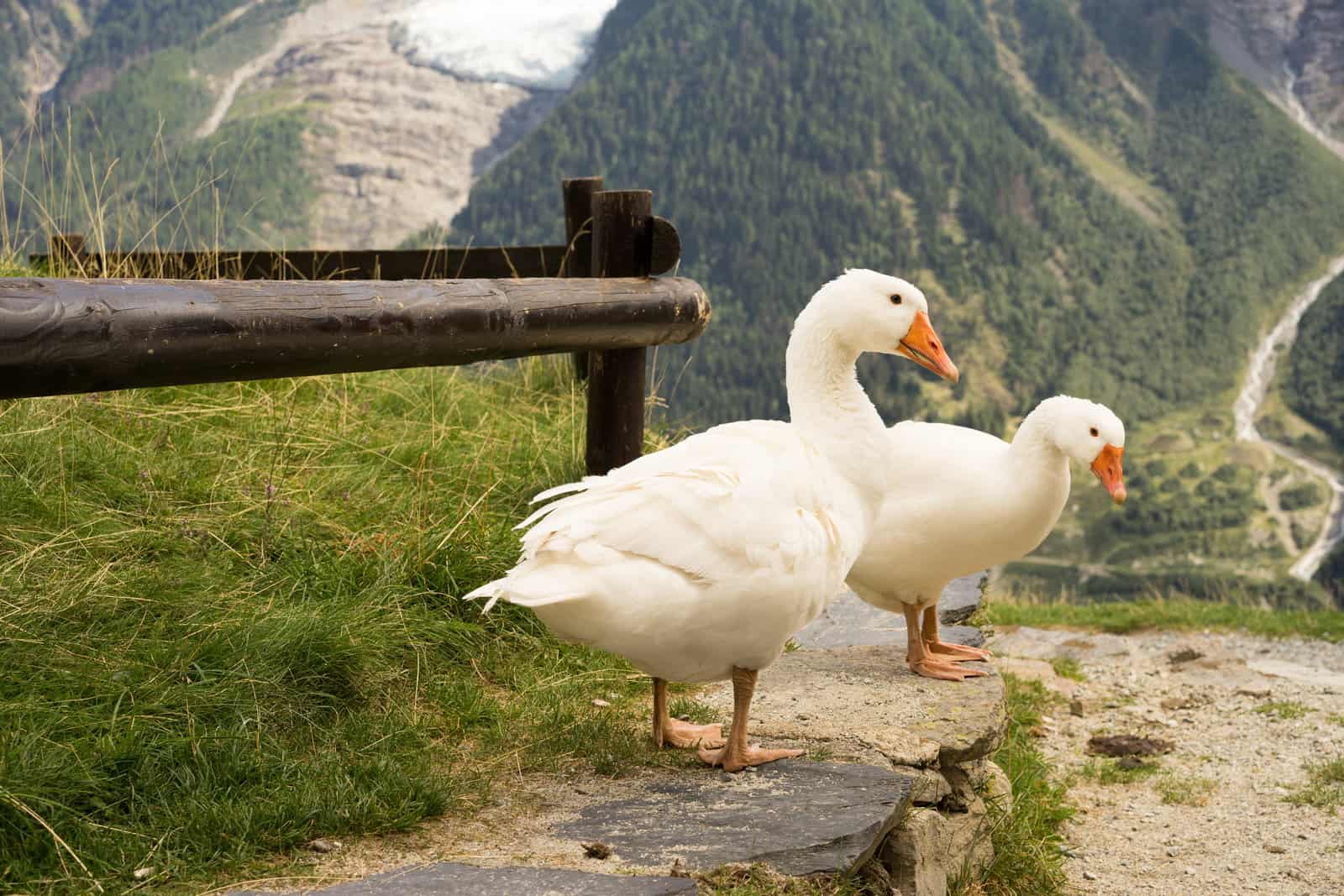
Characteristics
The legs of geese are black or dark brown, and their beaks are curved and differ in colour according to the breed, including black, red and yellow. Most geese breeds have a loud voice except for one called the silent goose, and geese spend most of their time swimming in the water, whether in lakes, ponds or rivers and enjoy high agility in their movements.
The goose reaches a length of about one and a half meters, and its wingspan is approximately 2.2 meters when spread out. It feeds on aquatic plants.
Geographical distribution
Geese are found in temperate regions and rarely live in the tropics. There are five strains in the northern half of the earth. There is one strain in New Zealand and Australia and another strain that lives in South America. However, it is not found in northern South America or Africa. There are strains that migrate either partially or entirely and are abundant in France, Britain and Ireland.
Famous Types of Goose
Among the types of waterfowl that range in size from the size of a pelican to a large duck, and there are many types of geese, including the following:
· Barnacle goose
The length of these geese ranges between 60 to 70 cm, and they live in swamps and coastal grasslands and feed mainly on herbs, seeds and leaves, and their white face distinguishes their appearance with a continuous black line from the eye to the beak.
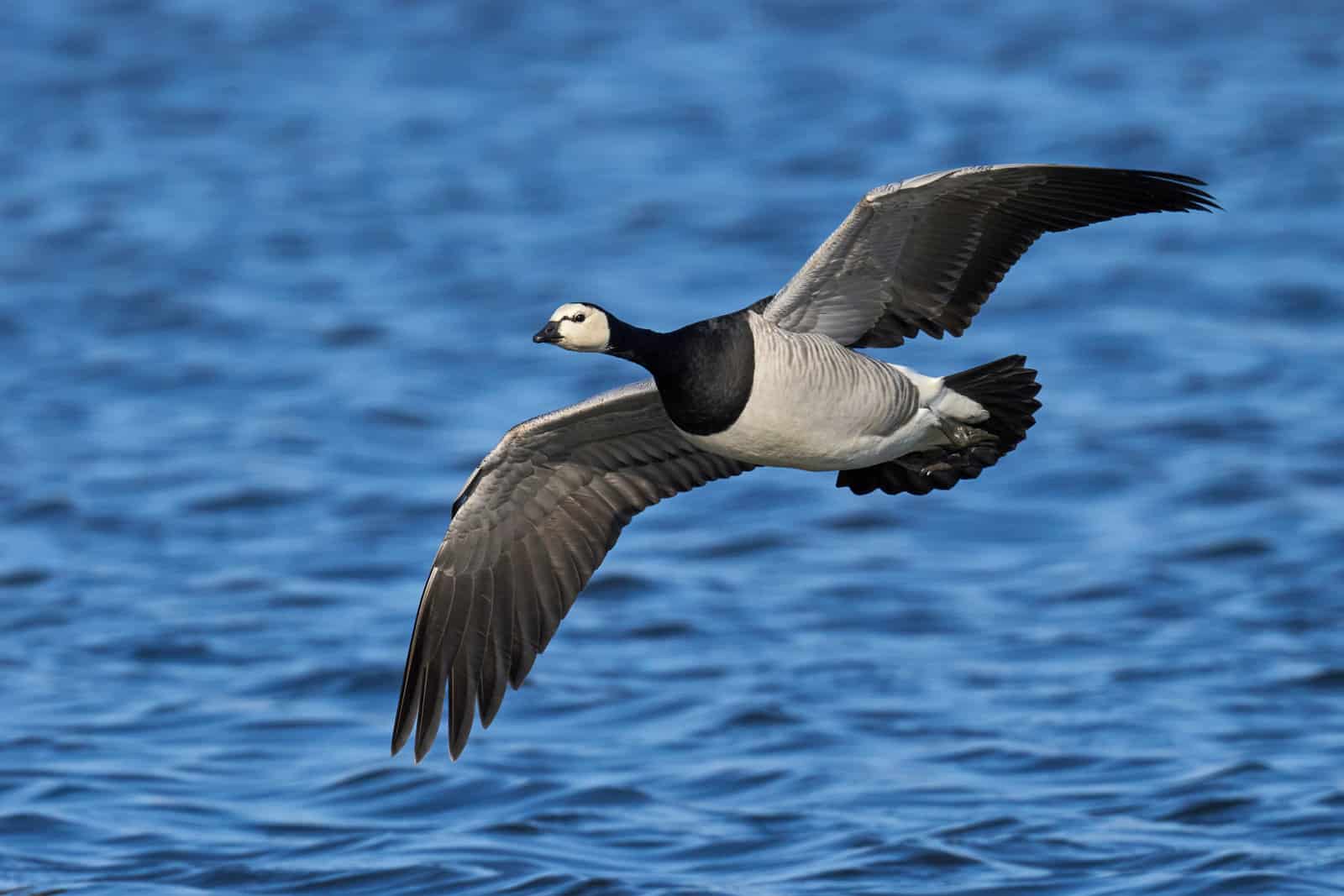
· Brent goose
Black geese are named in relation to the blackness that spreads in most of their parts, such as the head, neck, and legs. This species lives in estuaries, agricultural lands, and low coastal areas where seaweeds and algae grow. Its typical length is approximately 60 cm.
· Cackling goose
The shape of this species is characterised by a black head and neck and a white chin strap, and its typical length is between 56 – 76 cm. It lives in coastal swamps, tundra, streams and floodplains and depends on seeds, herbs and aquatic plants for its food, in addition to eating molluscs, insects and crustaceans.
· Egyptian goose
The length of the typical Egyptian goose is between 63–73 cm, and it feeds on seeds, herbs, stems and leaves of plants, in addition to eating worms, insects, and small animals, and this type of goose lives in wet areas, lakes, swamps, south of the desert, the Nile Valley, and rivers.
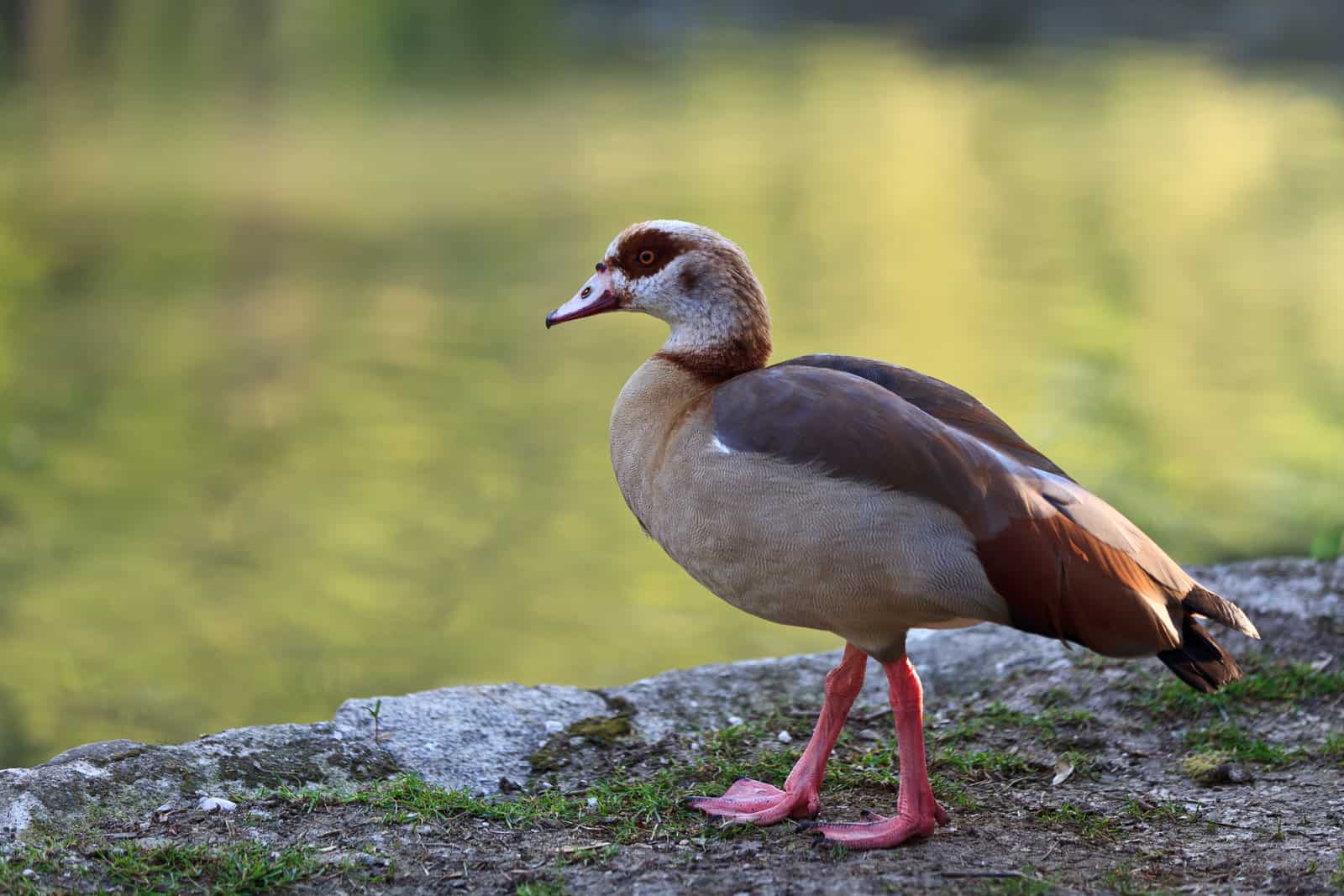
· Canada goose
This species is characterised by a white chin stripe and a light brown chest, and its typical length ranges between 76 to 110 cm. It lives in lakes, rivers, and fields, where its food source is available from seeds and aquatic weeds, in addition to eating insects, crustaceans, and molluscs.
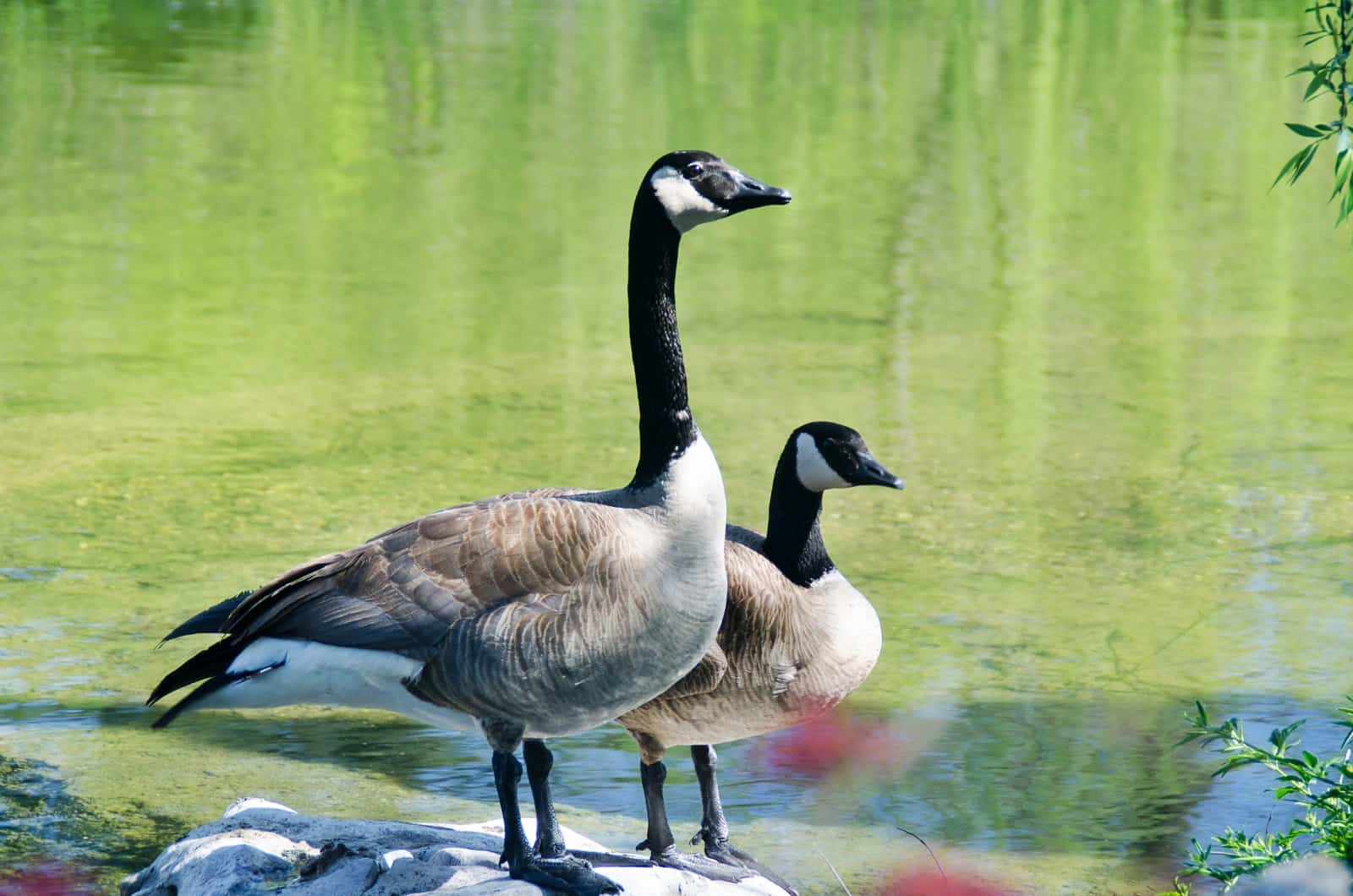
· Hawaiian goose
Also called the Hawaiian goose, it has wrinkled sides in the neck area, a black chin and a dark ring at the end of the neck, and its typical length is about 41 cm. It is endemic to the lava plains and grasslands of Hawaii, feeding on berries, herbs, and shrubs.
· Red-breasted goose
This name names this species in relation to the presence of a chestnut red colour in the thighs and chest, and its typical length is between 53-56 cm. Red-breasted geese feed on wheat, barley, corn, and grass, in wooded and lake tundra areas.
· Bar-headed goose
Broad black stripes characterise this species on the head, extending down and behind the neck. Its typical size ranges between 71-76 cm. It depends on grasses, barley, wheat, rice, and aquatic plants. It also lives in wetlands, cultivated fields, and lakes.

· Bean goose
This species appears with a dark brown neck, head and wings, and its typical length is between 68-90 cm. It feeds on aquatic plants, algae, berries, grains, and grazes in potato fields. It is also concentrated in wetlands, lakes, swamps, and fields.
· Greylag goose
The underparts of the goose are grey. The belly is white, and the feathers, head and neck are greyish-brown. The typical length is between 75-90 cm. It feeds on grains, grasses, and root crops and also eats small aquatic animals found in swamps and lakes.
· Greater white-fronted goose
The length of this species is between 65-78 cm, and it is characterised by dark brown colour in the areas of the neck, head, and back. This species lives in wet grassy areas and salt marshes and feeds on wheat, potatoes, and herbs, and sometimes it eats insects and molluscs.
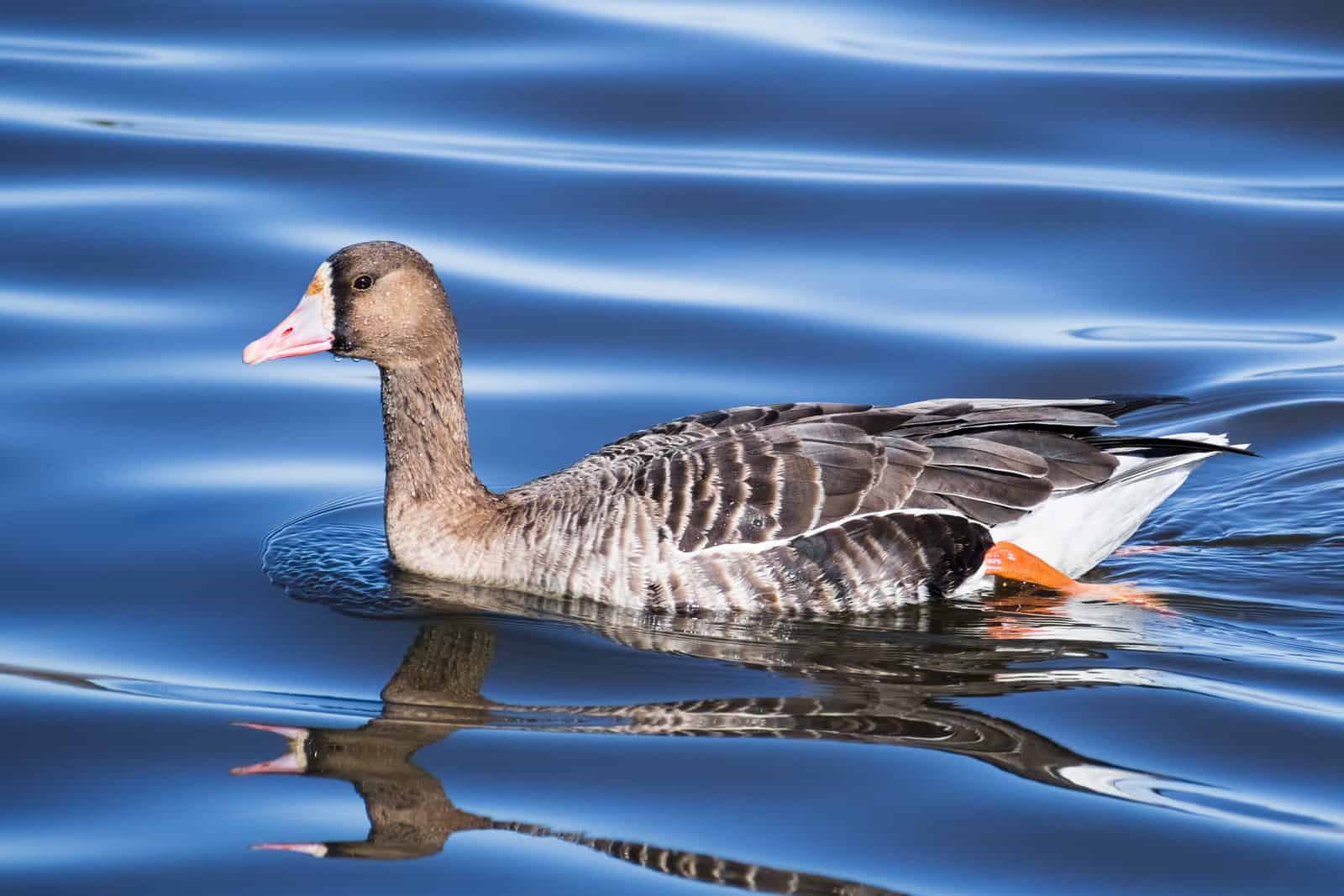
· Pink-footed goose
This species is characterised by having a round head, a small shape, and a short neck, which distinguishes it from other species, and its typical length is between 60-75 cm. It lives on the banks of rivers, salt marshes, slopes, and agricultural lands where its food is available such as roots, leaves, aquatic plants, and potatoes.
· Swan goose
It is also called the swan goose because of its long beak, similar to that of a swan, and chestnut brown colour extends in the nape area, and the typical length ranges between 81–94 cm. It feeds on sediment and aquatic vegetation in wetlands and estuaries.
· White-fronted goose
This species is distinguished by its white colour of the front end and grey-brown plumage, and its typical length ranges between 65–78 cm. It also feeds on potatoes, wheat, and grasses, and sometimes it eats insects and molluscs. It is endemic in estuaries, salt marshes, and wet grasslands.
· Emperor goose
A white neck and head, a short beak, a thick bluish-grey body, and a white tail characterise this species. It feeds on grasses and seaweeds, in addition to crustaceans and molluscs available in its habitats, such as grasslands, salt marshes, and mudflats.
· Ross’s Goose
This species has two feet, two legs, and a small reddish-pink beak, and its feathers are white with black tips, and its typical length ranges between 57-64 cm. It feeds on grasses, buds, and grains and lives in wetlands, arctic tundra, and agricultural fields.
· Snow Goose
This type is found in nature in two colours. Either in snow-white, the tips of the wings are coloured black or blue, and the tips are coloured white. The length of this species ranges between 63–79 cm. It settles in wetlands where aquatic plants, insects, and roots are abundant.
· Andean Goose
This species is characterised by the dominance of the white colour in its body except for the tail and wings, which are coloured black, the legs are reddish-orange, and its typical length is between 75–80 cm. This species feeds on sediments and aquatic plants that grow in wetlands.
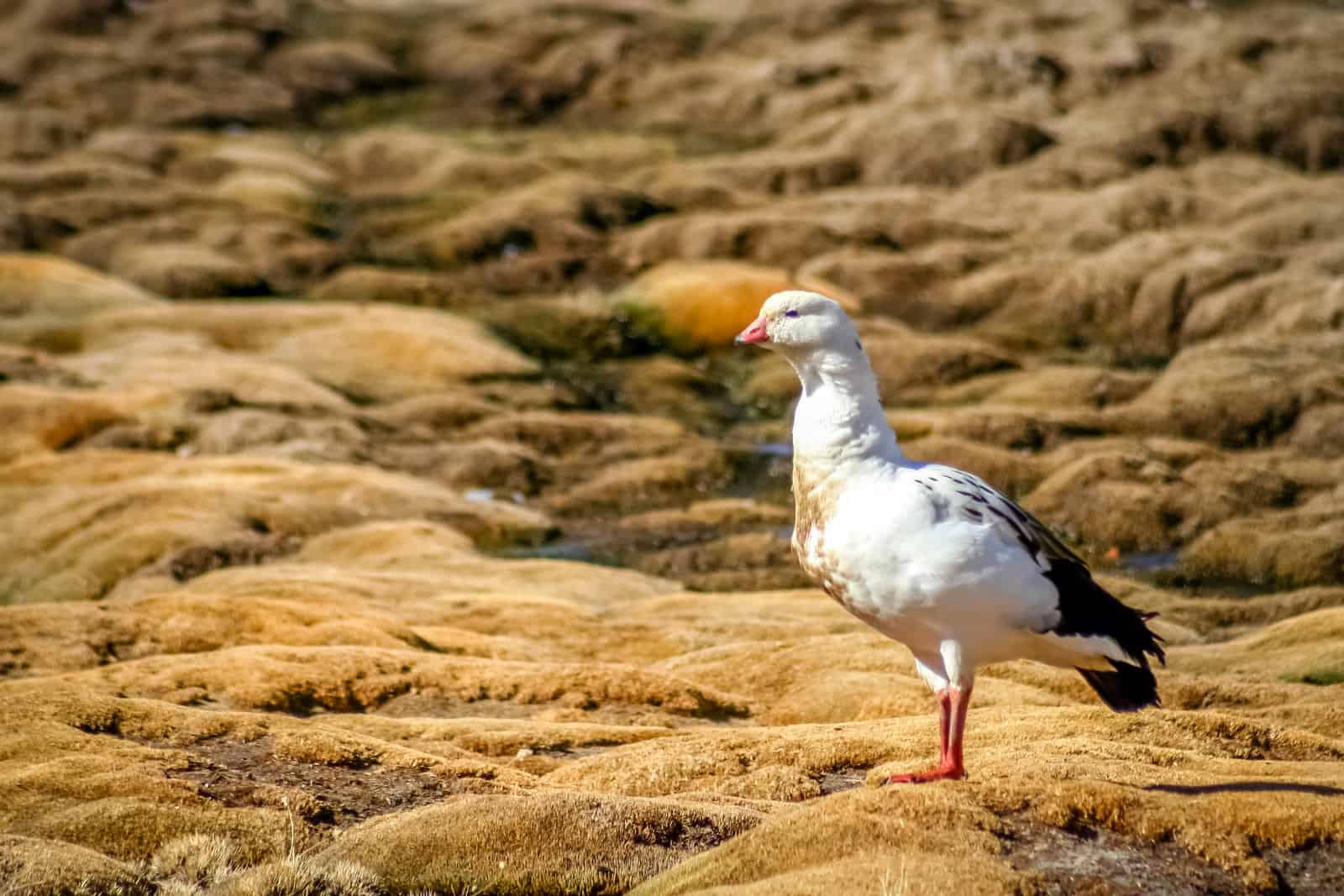
· Kelp goose
The shape of this species differs according to the sex of the bird. The male appears completely white, while the female appears with a dark brown neck and head, and the limbs are white. The typical length of this species ranges between 55-65 cm. It feeds mainly on seaweed in freshwater lakes and coasts.
· Blue-winged goose
The name of this species indicates that it has blue wings with a full brown and grey body. It lives near swamps, grasslands, and freshwater lakes. This species feeds on grass and small reptiles, and its typical length ranges between 60–75 cm.
· Cape Barren goose
This species is huge, with a length of 75–100 cm. Its feathers are pale grey, with black spots on its wings. It feeds on herbs such as spears and tusks, in addition to alfalfa and barley grass, which are widespread in offshore islands.
· Magpie goose
The feathers of the raging goose are coloured black and white, distinguished by a small beak and orange legs, and its length ranges between 75-90 cm. Its food source depends on small invertebrates, roots, rice, and aquatic plants. This species is endemic in floodplains, fresh water, and humid lands.
· Orinoco goose
This species lives in swamps, forest lakes, savanna areas and wetlands, and is characterised by a grey neck and head, chestnut brown wings, reddish pink feet and legs, and its length varies between 61 – 76 cm. It feeds on larvae, slugs, and insects.
· Spur-winged goose
This species has a sizeable reddish-pink beak, and the skin of its face is exposed in the frontal area of the eyes, reaching a length of between 75-115 cm. It feeds on seeds, aquatic plants, and grasses and sometimes eats small fish and insects. It lives in floodplains, grasslands, and wetlands.
What are best types of geese for breeding?
It is easy to raise geese indoors. They feed on plant foods, which makes them a profitable investment, and despite that, they need good health care, and the goal of raising geese can be determined, including choosing the best type for breeding, as follows:
Egg production
Geese do not produce eggs throughout the year, but seasonally, geese eggs have many benefits. It is similar to chicken eggs in terms of quality, nutritional value, and taste.
Among the types of geese that are a good source for egg production are Coban geese, which produce approximately 80 eggs. Chinese geese, which produce up to 70 eggs, and large grey geese, which produce approximately 40 eggs per season.
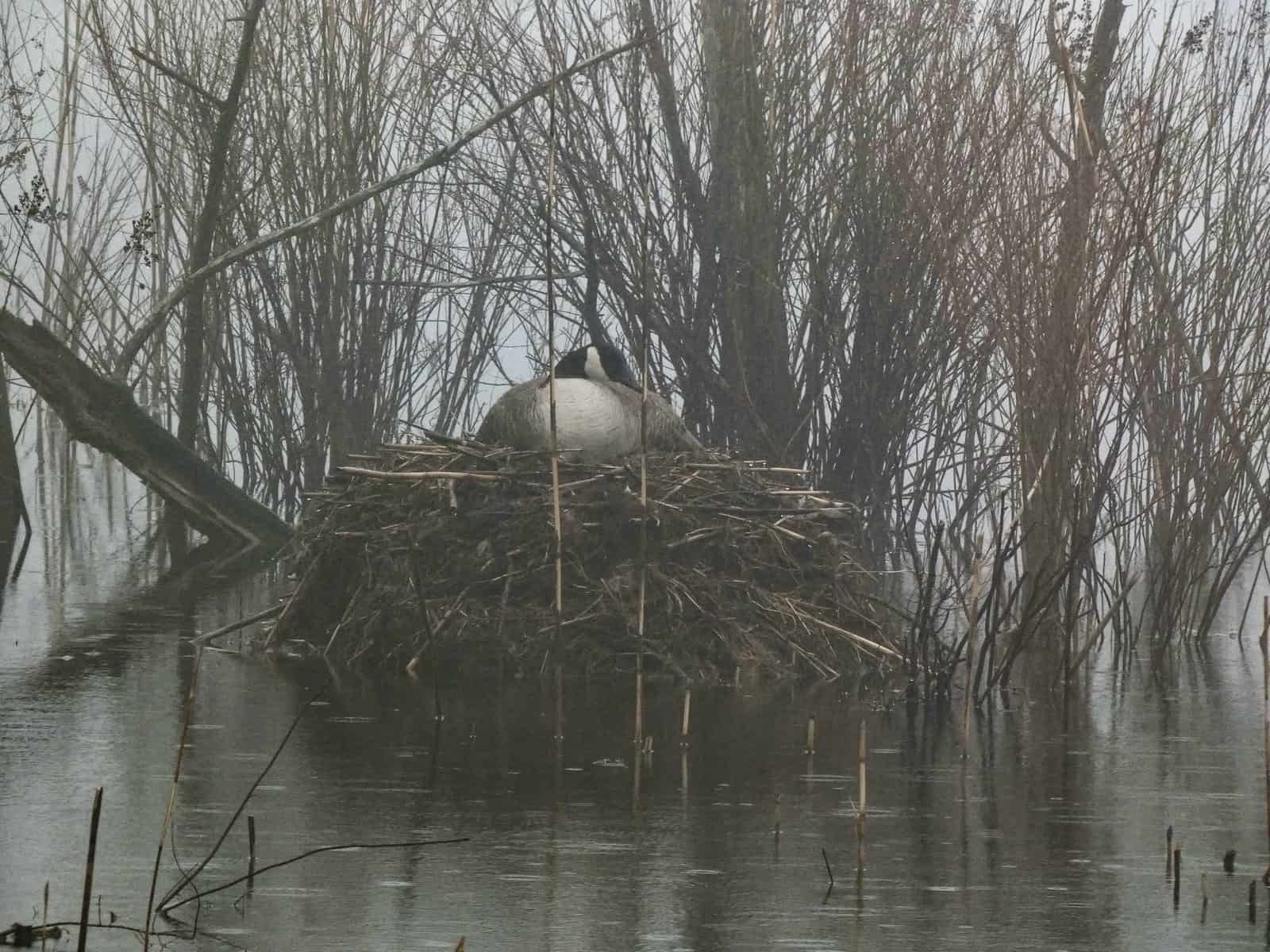
Meat production
For meat production, it is possible to choose geese characterised by a rapid growth rate and maturity and good resistance to diseases, and among these types is the small Glue goose, which grows within three months to reach a weight of 3.6 to 4 kg. However, it does not need special care. In terms of shape, the Egyptian geese are considered the most satisfying, and this is due to their colouring in different shades of brown in a beautiful way.
Geese are among the birds that are of benefit to farmers. Not only do they raise their income rate as a source of meat, eggs, and rich fats, but their soft feathers can be used in the production of clothing and bedding. The geese bird is characterised by its rapid adaptation to families in homes, and its sharp voice is an excellent warning to protect the home and its owners. It also can live in coastal and wet water areas, which are characterised by hot climates. It also depends on grass and herbs for its food. So, it is considered helpful if you want to eliminate it.
Goose Hunting
Geese can be hunted by making a hole a meter deep near their location at a distance of 15 meters, i.e. near lakes, rivers, or any place with swamp water, then the hunter puts a few stones around the hole; So that he can hide in it without being seen by the geese, then the hunter comes in the early morning, shortly before sunrise, and hides in the hole and puts a piece of burlap over the hole while he is inside it and waits for the geese to come to the water.
When the geese dip their heads in the water in search of their food, the hunter aims the gun at them and hunts what is in the lake, and the geese that fled and flew shoot it again while it is a bird and hunt it, in this way he can catch as many geese as possible.
Breeding Geese
Geese are waterfowl of medium size compared to the size of ducks and swans, as they live in fresh water in the northern hemisphere, and geese descend from 3 families, namely:
- Grey geese.
- Black geese are like Canadian geese.
- White geese are like wild geese.
To raise geese in the best way, you must know and follow the following criteria:
· Choosing the right type of geese
Choosing the right type of geese to raise is the first and most crucial step. Some geese are aggressive, and others are used for guarding purposes, while some are treated as pets, and when you want to get calm and non-aggressive geese, it is preferable to choose young geese or young geese, and it is preferable to buy at least two so the goose does not feel lonely.
· Providing the right place
The preparation of the appropriate place for breeding geese is straightforward. As its needs are generally simple, all it needs is a natural shelter with good shade to protect from hot weather and high winds, with an excellent fence to protect it from predators.
Although geese can defend themselves better than chickens and ducks, they cannot fly well, which makes their eggs and chicks vulnerable to predation by raccoons, skunks and other predators. In this case, it is preferable to bring a dog to protect the geese or increase the height of the fence to 1.8 meters. m to prevent predators from reaching it.
· Providing food and water
when the goose is fully grown to become an adult, it can take care of itself except for the danger of predators. Contrary to what many people think, geese do not need to grow in aquatic environments, so if they are cared for indoors, they do not need a natural water source.
Unlike ducks, the goose will only spend some day in the water, even if it has the opportunity to do so. All that must be done is to provide a source of water for drinking whenever it wants to. As for the food of geese, it is usually preferable to search for its food. It does not need to provide its food to others except at the beginning of its life and on freezing days, and it can also be provided with some nutritional supplements.
Feeding young geese requires the presence of fodder, and they can be provided with supplementary feed with fresh vegetables or herbs. It is mentioned that in the first six weeks, geese get only 22% of protein from grains, and care must be taken when feeding their young from commercial fodder. This is due to the diseases caused by coccidia parasites.
Caring for geese eggs
Goose eggs are taken care of through 3 methods, which are explained in the following:
- Allowing the mother goose to sit on the eggs until their hatching time by leaving them in the nest.
- Using a broody hen to sit on eggs, and when choosing this method, special care must be taken for young geese.
- The eggs are incubated using the artificial goose egg incubator, a machine that nurses the eggs from day 4 to day 27, with the eggs cooled and moistened daily.
The period of incubation of geese for eggs ranges between 28–32 days, and its temperature must remain at a rate ranging between 37–38°. Eggs that are more than seven days old must not be touched, and it is forbidden to transfer eggs from the incubator to another place, except after passing 21 days, to perform the flipping process.
Caring for goslings
Taking care of baby geese and raising them is easy. As goslings require less time to take care of them compared to young chickens, young geese are taken care of by following the following steps:
- First, temporarily place them in a well-ventilated box-shaped incubator. Feed it well, as the food must be replaced and changed three times a day.
- Provide water in large quantities, especially in the first weeks after the egg-hatching process.
- Take it out to the grass, but on condition that suitable temperatures are chosen below 10° while monitoring it permanently.
- Keep it outside when it is two months old so they can get food and water themselves. Build a shelter for her to go to at night when she sleeps, which may be in the form of a barn or shed or part of the car garage.
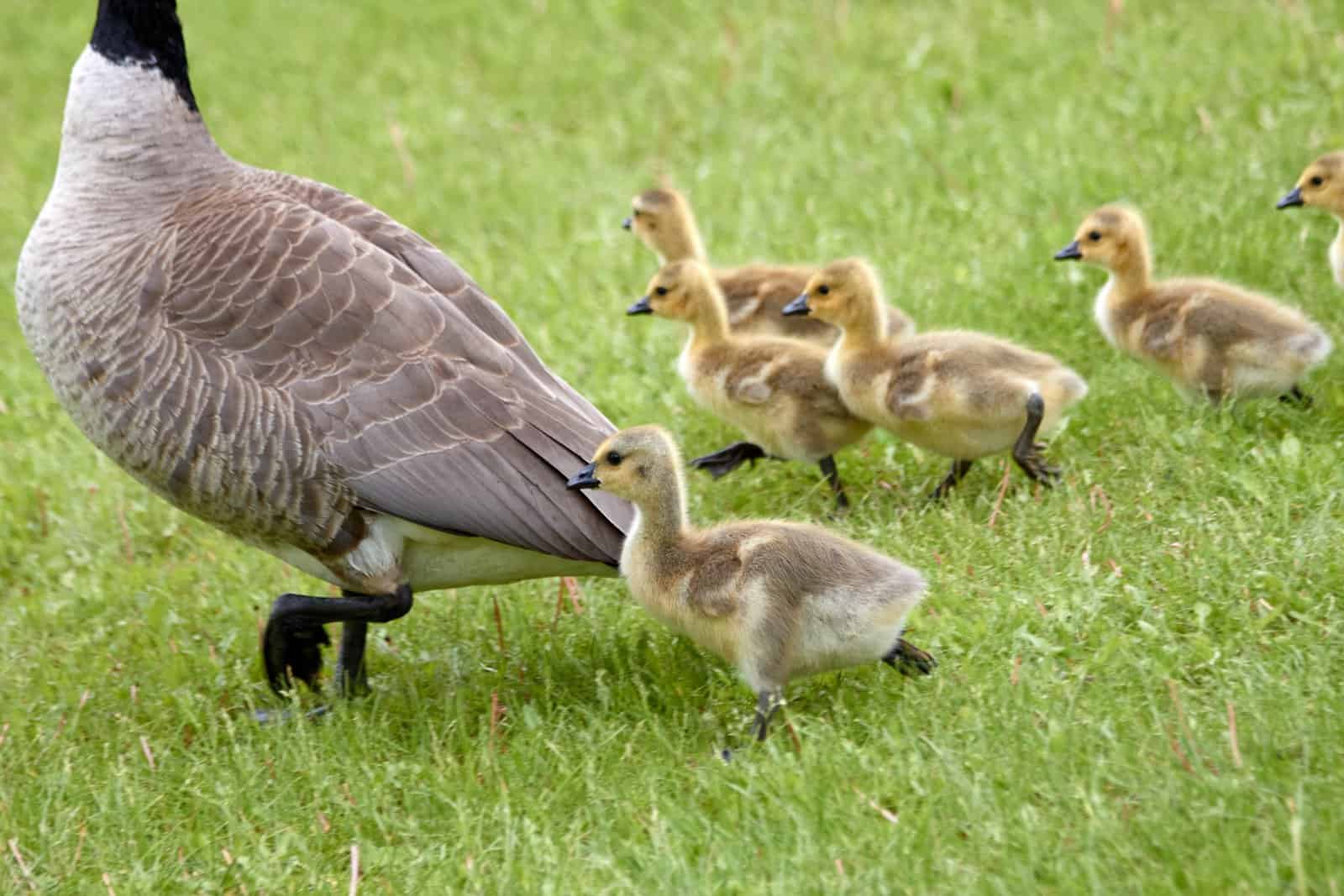
Geese breeds
The local breeds of geese are descended from the species of wild geese, which migrate to all parts of the world. These breeds are divided as follows:
· Toulouse breed
The Toulouse breed originated in France, one of the non-incubating breeds that tend to grow very slowly, producing the equivalent of 35 eggs per season. Its meat is described as difficult to cut and chew compared to the meat of the Embden breed.
· Embden breed
The Embden breed originated in Germany, and it is one of the famous breeds in the city of New South Wales. It is considered one of the breeds with high production, characterised by being non-aggressive and calm in nature.
· Chinese breed
The Chinese breed originated in China and is divided into two main types: white Chinese geese and Chinese brown geese. The Chinese geese breed is generally smaller in size compared to the Toulouse and Embden breeds, and this strain is distinguished from others by the presence of a prominent bump in the head area.
· Roman breed
The Roman dynasty originated in Europe and is considered one of the ancient European dynasties. It is a mixture of the Toulouse and the Embden but is somewhat similar to the Embden.
· African breed
The African breed results from mating the Chinese strain with the Toulouse strain. Unlike the Chinese breed, it is considered one of the strains with low egg production.
· Sebastopol breed
The Sebastopol breed is one of the famous breeds, and it is a type of domesticated goose, as it has long, slender necks and webbed feet. This makes them adept at swimming, and this strain is characterised by its white feathers. It has long curved wings on its back, as well as short, curly white feathers on the lower part of its body.
The benefits of raising geese
You can benefit from geese in several areas. The most prominent of these benefits are the following:
- Guard: The geese are distinguished by their ability to detect abnormal sounds.
- Food and trade: Benefit from its meat, liver, and feathers, and it is also possible to eat goose eggs and make food with a delicious taste.
- Expelling wild cats: Geese can drive away small predators.
- Weed removal: This saves the time and money required to purchase pesticides.
- Entertainment: Geese are friendly and curious birds that can be used for entertainment and entertainment.
If you enjoyed this article why not check out some more Geography Facts and Topics: Mountains, Rainbows, Hurricanes, Thunderstorms, Islands, Blizzards, Volcanoes and Continents.
Why not subscribe for as little as £1.99 per month to access over 1000 fun educational videos!


Leave a Reply